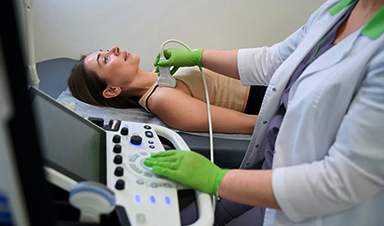Scientists have developed a DNA nanoflower that delivers chemotherapy and gene therapy directly to breast cancer cells, boosting effectiveness while reducing side effects in early tests.
Breast cancer continues to be one of the most prevalent cancers worldwide. Although drugs like Doxorubicin (DOX) are commonly used, their effectiveness is often limited by toxicity, poor targeting, and the development of multi-drug resistance. DNA nanostructures, due to their biocompatibility and programmability, are gaining attention as more precise delivery vehicles.
Researchers have created a new DNA nanoflower-based drug delivery system capable of co-delivering an antisense oligonucleotide (ASO) and the chemotherapy drug DOX.
Published in Micro & Nano Letters, the study demonstrates how they used a dual amplification method to form a flower-shaped DNA nanostructure with a high drug-loading capacity and highly targeted delivery.
This study focuses on tackling the limitations of traditional DOX-based therapies by combining gene silencing and chemotherapy into one delivery system. The DNA nanoflowers are also functionalised with AS1411, an aptamer that binds to nucleolin (a protein overexpressed on many tumour cells), improving targeting accuracy.
Building the DNA Nanoflower
The research team used a two-step amplification process to construct the nanoflowers. First, they used rolling circle amplification with Phi29 DNA polymerase to produce long single-stranded DNA sequences with repeating units. These sequences were then further amplified using multiplexed enzyme amplification, forming the unique nanoflower structure.
Specific sequences were engineered into the DNA scaffold to carry both the ASO and DOX drugs. ASO targeted PLK1, a gene associated with cancer cell growth and division, while DOX was intercalated directly into the DNA structure, making use of its natural affinity for DNA bases.
The AS1411 aptamer was conjugated to the nanostructure to enable tumour-specific targeting. The team confirmed the structure’s size, morphology, and successful functionalisation using a range of analytical techniques, including transmission electron microscopy, dynamic light scattering, and gel electrophoresis.
In Vitro and In Vivo Testing
In vitro experiments were carried out using MCF-7 breast cancer cells to assess cellular uptake, gene silencing, cytotoxicity, apoptosis, and cell migration. The researchers used flow cytometry, CCK-8 assays, qRT-PCR, western blotting, and Transwell migration assays to evaluate these parameters.
The in vivo phase of the study used nude mice implanted with MCF-7 cells to form breast tumours. Once tumours had developed, mice were treated locally with the nanoflower formulations.
Promising Results in Early Tests
Analysis of the DNA nanoflowers showed their high drug-loading efficiency and their uniform, flower-like shape. The aptamer-functionalised structures showed significantly enhanced uptake in cancer cells compared to non-targeted controls.
In lab tests, the nanoflower carrying both ASO and DOX (referred to as DNF-ASO@DOX) reduced tumour cell proliferation and triggered apoptosis more effectively than either DOX or ASO alone. The ASO silenced PLK1 expression, confirmed at both the mRNA and protein levels, and resulted in cell cycle arrest and increased cell death.
The system allowed for controlled drug release in response to enzymatic signals, specifically FEN1, which is overexpressed in tumour cells. This meant the active agents were mainly released at the tumour site, minimising damage to healthy tissue.
In animal studies, tumours treated with DNF-ASO@DOX showed markedly reduced growth. Tissue analysis revealed higher levels of apoptosis and lower PLK1 expression in tumour cells. Blood tests and organ inspections indicated minimal systemic toxicity, supporting the biocompatibility of the nanoflower platform.
Looking Ahead
The study highlights the potential of DNA nanoflowers as a new kind of combination therapy tool, able to deliver both genetic and chemotherapeutic treatments in a highly targeted way. With its tumour-specific binding and controlled release mechanisms, the platform could offer a new route to overcome issues like multi-drug resistance and off-target side effects that currently limit breast cancer treatments.
Journal Reference
Shen X., Zhu A., et al. (2025). DNA Nanoflower Enables Controlled Co-Delivery of Antisense Oligodeoxynucleotide and Doxorubicin for Anti-Breast Cancer Treatment. Micro & Nano Letters. DOI: 10.1002/mnnl.202500008, https://ietresearch.onlinelibrary.wiley.com/doi/10.1049/mna2.70008
News
After 150 years, a new chapter in cancer therapy is finally beginning
For decades, researchers have been looking for ways to destroy cancer cells in a targeted manner without further weakening the body. But for many patients whose immune system is severely impaired by chemotherapy or radiation, [...]
Older chemical libraries show promise for fighting resistant strains of COVID-19 virus
SARS‑CoV‑2, the virus that causes COVID-19, continues to mutate, with some newer strains becoming less responsive to current antiviral treatments like Paxlovid. Now, University of California San Diego scientists and an international team of [...]
Lower doses of immunotherapy for skin cancer give better results, study suggests
According to a new study, lower doses of approved immunotherapy for malignant melanoma can give better results against tumors, while reducing side effects. This is reported by researchers at Karolinska Institutet in the Journal of the National [...]
Researchers highlight five pathways through which microplastics can harm the brain
Microplastics could be fueling neurodegenerative diseases like Alzheimer's and Parkinson's, with a new study highlighting five ways microplastics can trigger inflammation and damage in the brain. More than 57 million people live with dementia, [...]
Tiny Metal Nanodots Obliterate Cancer Cells While Largely Sparing Healthy Tissue
Scientists have developed tiny metal-oxide particles that push cancer cells past their stress limits while sparing healthy tissue. An international team led by RMIT University has developed tiny particles called nanodots, crafted from a metallic compound, [...]
Gold Nanoclusters Could Supercharge Quantum Computers
Researchers found that gold “super atoms” can behave like the atoms in top-tier quantum systems—only far easier to scale. These tiny clusters can be customized at the molecular level, offering a powerful, tunable foundation [...]
A single shot of HPV vaccine may be enough to fight cervical cancer, study finds
WASHINGTON -- A single HPV vaccination appears just as effective as two doses at preventing the viral infection that causes cervical cancer, researchers reported Wednesday. HPV, or human papillomavirus, is very common and spread [...]
New technique overcomes technological barrier in 3D brain imaging
Scientists at the Swiss Light Source SLS have succeeded in mapping a piece of brain tissue in 3D at unprecedented resolution using X-rays, non-destructively. The breakthrough overcomes a long-standing technological barrier that had limited [...]
Scientists Uncover Hidden Blood Pattern in Long COVID
Researchers found persistent microclot and NET structures in Long COVID blood that may explain long-lasting symptoms. Researchers examining Long COVID have identified a structural connection between circulating microclots and neutrophil extracellular traps (NETs). The [...]
This Cellular Trick Helps Cancer Spread, but Could Also Stop It
Groups of normal cbiells can sense far into their surroundings, helping explain cancer cell migration. Understanding this ability could lead to new ways to limit tumor spread. The tale of the princess and the [...]
New mRNA therapy targets drug-resistant pneumonia
Bacteria that multiply on surfaces are a major headache in health care when they gain a foothold on, for example, implants or in catheters. Researchers at Chalmers University of Technology in Sweden have found [...]
Current Heart Health Guidelines Are Failing To Catch a Deadly Genetic Killer
New research reveals that standard screening misses most people with a common inherited cholesterol disorder. A Mayo Clinic study reports that current genetic screening guidelines overlook most people who have familial hypercholesterolemia, an inherited disorder that [...]
Scientists Identify the Evolutionary “Purpose” of Consciousness
Summary: Researchers at Ruhr University Bochum explore why consciousness evolved and why different species developed it in distinct ways. By comparing humans with birds, they show that complex awareness may arise through different neural architectures yet [...]
Novel mRNA therapy curbs antibiotic-resistant infections in preclinical lung models
Researchers at the Icahn School of Medicine at Mount Sinai and collaborators have reported early success with a novel mRNA-based therapy designed to combat antibiotic-resistant bacteria. The findings, published in Nature Biotechnology, show that in [...]
New skin-permeable polymer delivers insulin without needles
A breakthrough zwitterionic polymer slips through the skin’s toughest barriers, carrying insulin deep into tissue and normalizing blood sugar, offering patients a painless alternative to daily injections. A recent study published in the journal Nature examines [...]
Multifunctional Nanogels: A Breakthrough in Antibacterial Strategies
Antibiotic resistance is a growing concern - from human health to crop survival. A new study successfully uses nanogels to target and almost entirely inhibit the bacteria P. Aeruginosa. Recently published in Angewandte Chemie, the study [...]






















